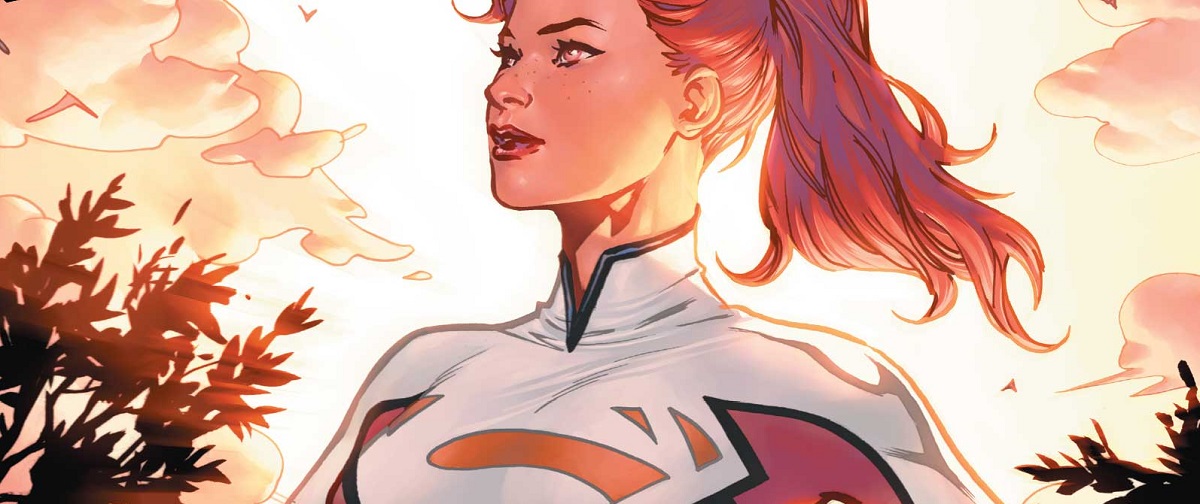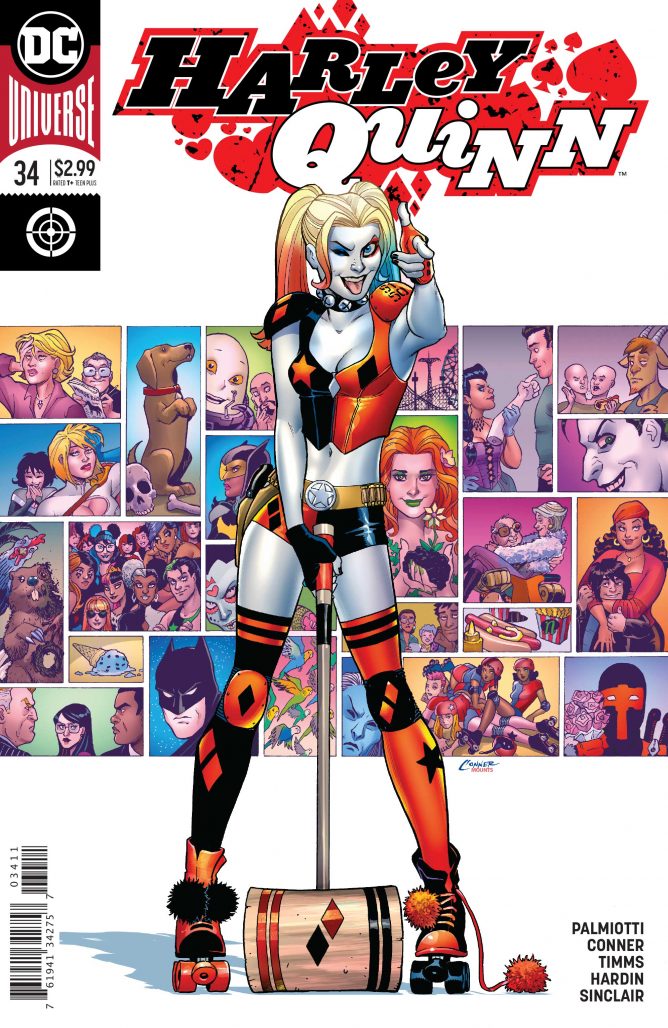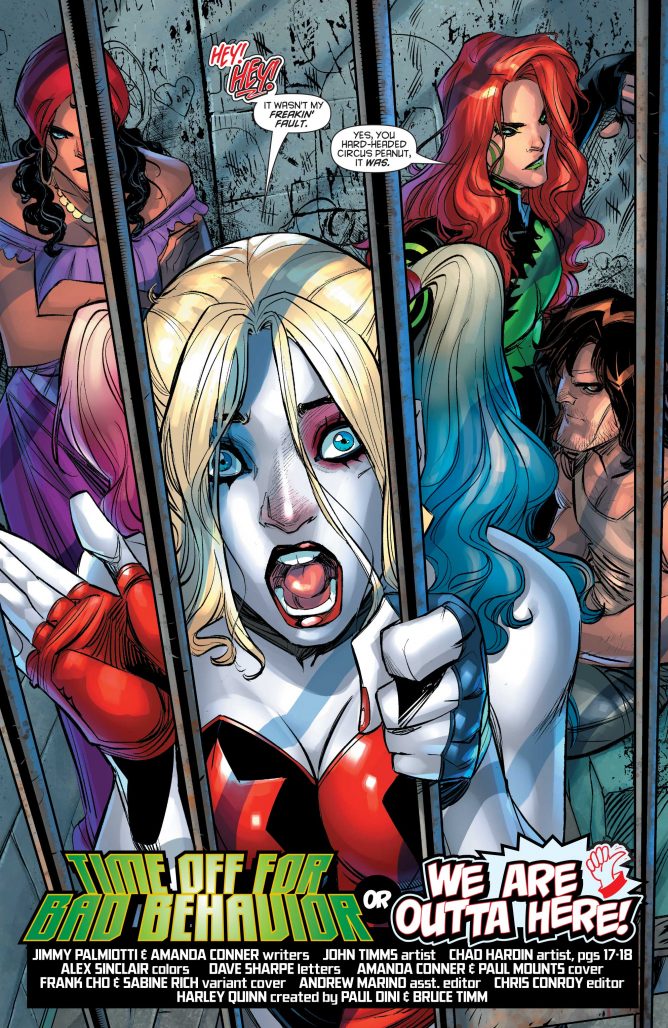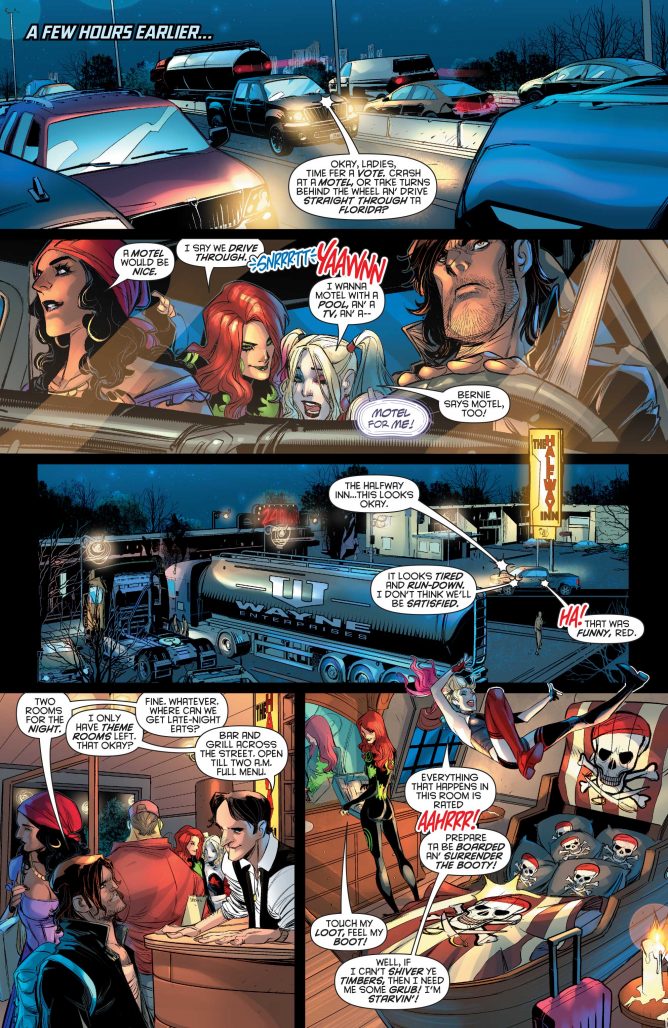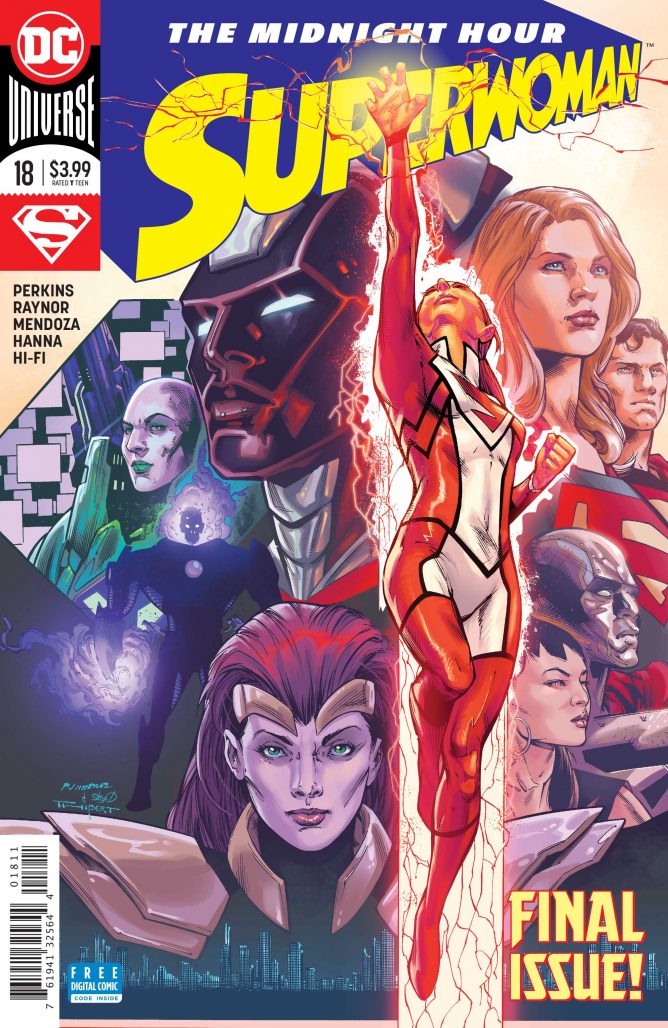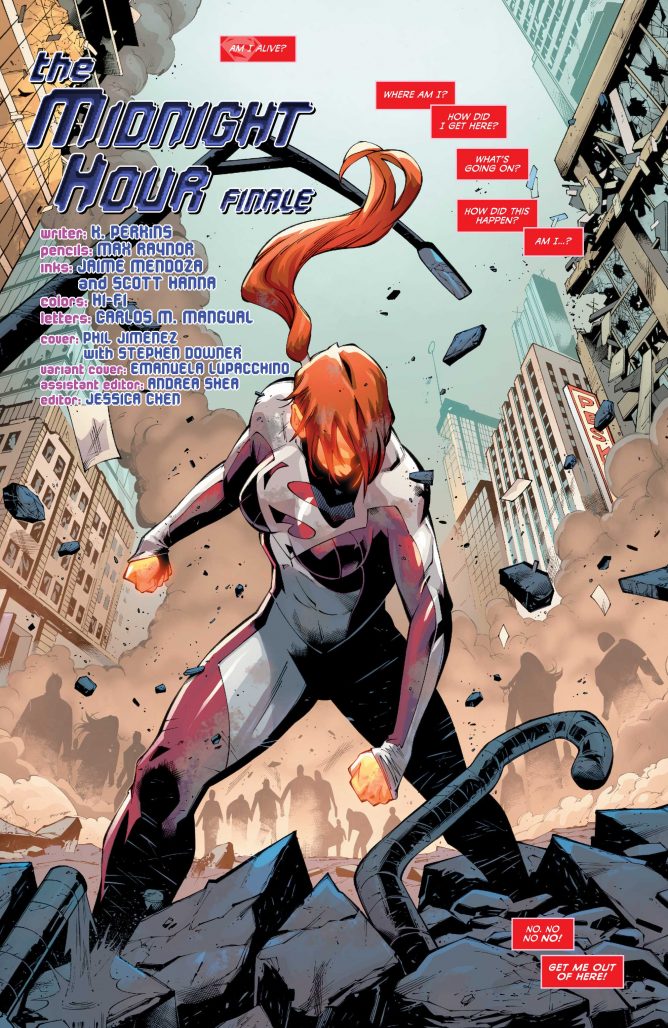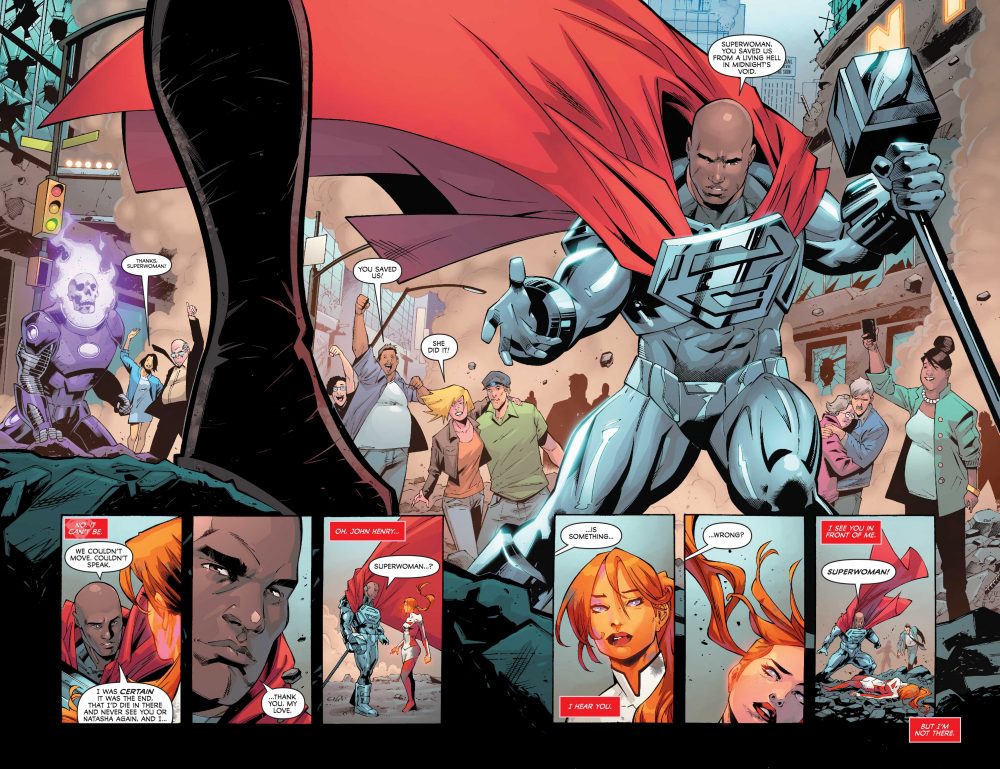In June 2016, DC Comics kicked off the start of its Rebirth initiative. After a wave of criticism surrounding the way they have treated their characters’ rich histories since 2011’s New 52 relaunch, DC has decided to rebrand. They hope that by restoring their characters’ pasts, they will restore readers’ faith in them as well. Do they succeed? That’s what the Comics Beat managing editor Alex Lu, entertainment editor Kyle Pinion, and contributor Louie Hlad are here to discuss. Book by book. Panel by panel.
THIS WEEK: Alex looks at how Superwoman and this run on Harley Quinn choose to end.
Note: the reviews below contain **spoilers**. If you want a quick, spoiler-free buy/pass recommendation on the comics in question, check out the bottom of the article for our final verdict.
 Harley Quinn #34
Harley Quinn #34
Writers: Jimmy Palmiotti & Amanda Conner
Artist: John Timms with Chad Haroin
Colorist: Alex Sinclair
Letterer: Dave Sharpe
Love it or hate it, there’s no denying that Jimmy Palmiotti’s and Amanda Conner’s one of the definitive comics runs of our time. Over the last four years, Palmiotti and Conner, alongside a variety of zany artistic collaborators, have transformed Harley from a tragic and often abused love interest for the Joker into a hilarious and strongly independent force. In this current incarnation, Harley has rapidly become what is probably DC’s second most popular female character and what is definitely a modern cultural icon. Any way you slice it, Harley Quinn has been a hit both within comics and beyond, so it makes sense that Harley Quinn #34, the last issue of the series under Palmiotti’s and Conner’s hand, is a fun and lighthearted victory lap for the creators.
As a creative team’s goodbye to their character– and make no mistake, Harley is essentially Palmiotti’s and Conner’s character now– Harley Quinn #34 is basically perfect. The writers alongside artist John Timms and Chad Haroin don’t swing for the fences with zany hijinx and visual overload the way they have in past issues of the series, instead keeping the story confined to the people that Harley is closest to. That of course means that we get to spend more time exploring her relationship with Pamela Isley, aka Poison Ivy, which is another landmark development crafted by Palmiotti and Conner during their Harley Quinn run that I’ve come to fall in love with. Despite their classic characterization as clinically insane villains, Ivy and Harley have an oddly stabilizing effect on one another in this series. It’s not necessarily a healthy relationship for the world, as the two of them are more than willing to engage in violent hijinx on one another’s behalf, but it does seem quite fulfilling for the both of them, which makes it feel fulfilling to me.
Of course, beyond spending time with Harley’s SO, we also get to spend time with Harley’s blood family. The contrast between Harley’s neon biker aesthetic and her family’s generally well-to-do-suburban-white-family look cannot be overstated, so I love that that contrast belies the true loving nature of the Quinzel family’s interpersonal dynamic. We get some great moments out of Harley’s visit to her roots, including a great conversation with her mother and a visit to her favorite hyenas Bud and Lou, who have found peace and a family of their own.
And finally, we get to hang out with Jimmy and Amanda themselves. The book takes something of an Animal Man-esque move as Harley directly confronts her creators…who live in the same world as her? It’s kind of confusing and very much “What if God Was One of Us?”, but the core of this interaction is a perfect bit of fourth wall breaking that allows Harley to air out some long time grievances and to allow Palmiotti and Conner to respond to criticism of their own title. The whole affair is all very self aware, which perhaps sums up Harley Quinn in general.
All this serves to complete the arc that Harley Quinn has been working towards for a long time now. In many ways, prior to Palmiotti and Conner, Harley was a fundamentally different character. She was visually compelling, but reliant on her broken relationship with a psychopath in a way that limited her own growth. No longer. Harley Quinn is a force of nature all her own now, replete with enough caring family, loving partners, crazy sidekicks, and zany adventures to fill an omnibus or two on your shelf.
Verdict: Buy
 Superwoman #18
Superwoman #18
Writer: K Perkins
Penciller: Mak Raynor
Inkers: Jaime Mendoza & Scott Hanna
Colorist: Hi-Fi
Letterer: Carlos M. Mangual
When we come to stories, we come searching for a feeling. While many of us search for meaning in signs and symbols in the comics we read and the movies we watch, in the end we want to come away feeling fulfilled; like we subconsciously made sense of something mysterious within ourselves. That’s why the endings of stories often don’t and shouldn’t have to consciously make sense. Superwoman‘s final issue doesn’t– not completely– but ends up being more successful for it.
I won’t pretend to completely understand the concept of Midnight, the program-turned-robot that we’ve watched Lana Lang tussle with for the past several months. Midnight’s story is a very heavily sci-fi Pinocchio story, in essence, and it has often felt more than a little tropey. However, as a vehicle to distill Lana’s adventures over the last two years, Midnight performs an effective job, providing an outlet for the creative team behind Superwoman to wind and weave through a dreamscape filled with Lana’s closest companions. It’s not a unique concept, but one well suited to the ending of a story, as it allows us to spend time with the characters of this book consciously discussing how Lana has grown and changed since the first issue of Superwoman.
Indeed, way back when in Superwoman #1, Lana was a completely different person than the one we see here. Back then, Lana was an anxious farmgirl who saw her powers as the aftershock of a tragedy that took her best friend, another Clark Kent (don’t ask), away from here. But since then, Lana has grown into her own as a Superwoman. Indeed, her friend Maxima even praises her “levelheadedness” throughout her battles with Midnight. And Lois Lane, her fellow Superwoman, gets the opportunity to tell Lana how proud she is that Lana “finally believe[s] what everyone else already knew.” These are lovely period points on this character’s journey and serve to emphasize her growth, something that is further reinforced by the way that, instead of playing student to Lois’ Superwoman, she ends up playing teacher to Midnight, who has discovered that she possesses a modicum of human emotion.
What really tickles me most about Superwoman‘s ending, however, is how it emphasizes that superpowers aren’t an end in of themselves, but a tool to reach towards something greater. Throughout her time as Superwoman, we’ve watched Lana use her powers to make new friends and find her place in the world. She’s become more confident and self-assured since we first saw her. She’s a more complete person now. But at the end of the day, Lana Lang’s superheroics aren’t the core to her identity. As a young girl runs up to her at a cafe, she doesn’t ask for Lana’s autograph because she has powers, but because she’s a writer at the Daily Star. So it doesn’t really matter when Midnight is forced to take Lana’s powers away from her. She’s no less complete without them.
Superwoman #18 isn’t a perfect ending, but I don’t think there’s such a thing. Endings never really make sense. They don’t have to. They just need to leave us with a feeling. With an idea. And here, the core feeling is hope. The core idea is that anyone can be a hero. We just have to be brave enough to answer the call to adventure when it comes.
Verdict: Buy
Round-Up
- Mister Miracle #6 brings the stunning maxi-series to a midpoint climax. This issue, despite being relatively more action packed than the last one, feels a little smaller in scope. Most of it ends up being an extended conversation sequence worked into a sequence of challenges Barda and Scott have to get through in order to confront Orion. It’s a cool bit of narrative experimentation, both narratively and visually, and I’m angsty as hell that we’re going to have to wait a bit to see more from this incredible book.
Miss any of our earlier reviews? Check out our full archive!


